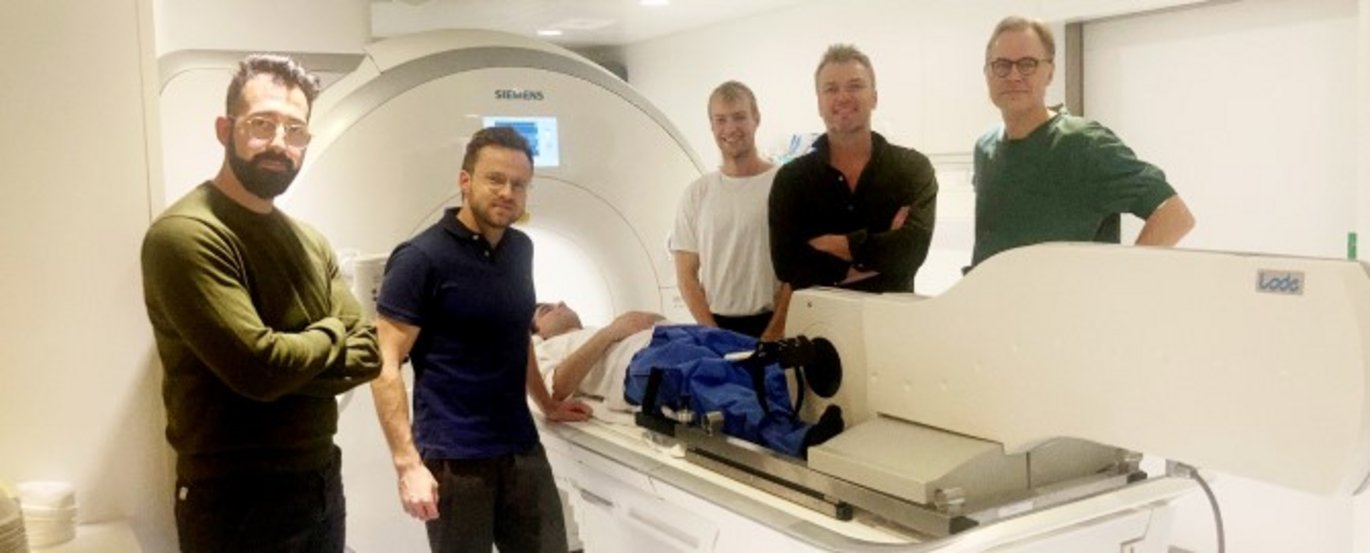Magnetic Resonance Imaging of children’s hearts enables us to combat heart failure
Combatting heart failure associated with diabetes and obesity is the mission of cardiologist Per Lav Madsen, Herlev-Gentofte Hospital and PhD student Morten Asp Vonsild Lund, Holbæk Hospital. With magnetic resonance scans they try to find early warnings to prevent heart diseases later in life.


Major population diseases, such as diabetes and obesity and their impact on our organs is the focal point of Per Lav Madsen’s research.
”Many of us will die prematurely from these diseases – often with years of severe morbidities, such as breathlessness, behind us,” says Per Lav Madsen.
He is a cardiologist and consultant at Herlev-Gentofte Hospital. In 2009 he relocated to Flinders University in Australia to become an expert in cardiac magnetic resonance imaging.
”With MRI, we can accurately measure the volume of the heart and how much it pumps. It is a great advantage to have a non-invasive standard when working with larger populations,” says Per Lav Madsen.
Study with children should clarify consequences of obesity
He is currently participating in a study of children with obesity aged between 10 and 15 years old. At the Children's Obesity Clinic at Holbæk Hospital his PhD student, Morten Asp Vonsild Lund, together with associate professor, pediatrician and head of section Jens-Christian Holm, are performing MRI scans of 100 children with obesity and 50 children of normal weight.
Morten A. V. Lund | “Our goal is, at an early stage, to investigate the effects of obesity on the heart and circulation. Hence, we study children from 10 to 15 years of age with obesity and normal weight, respectively. We look at the heart’s functionality, the size of the heart, its pumping and how stiff the children’s heart and circulation become as a consequence of early-life obesity,” says Morten Asp Vonsild Lund. |
The study also includes an evaluation of the effect of weight loss. Therefore, one MRI scan is performed prior to weight-loss intervention and another scan 18 months later. The research team has at present concluded the first scans.
“We observe enlarged hearts for the children with obesity. This is a clear indication of early changes probably being transferred into adulthood, which could lead to early onset of e.g. heart failure. However, to conclude this we need future follow-up studies on the lifetime health consequences of obesity in children,” says Morten Asp Vonsild Lund.
Per Lav Madsen continues; “Heart problems often manifest themselves if overweight leads to diabetes, and as many of these children also have early signs of diabetes, it is expected that a profound fraction of these children are at a high risk of cardiovascular disease later in life.” Thus, he is thrilled that the study will follow children over time and examine the effects of weight loss as well.
Study of adults with diabetes
A similar study at Slagelse and Næstved Hospitals with 300 adults with type 2 diabetes gives an idea of the problems which diabetes entails. This study will provide new knowledge enabling treatment to be planned in time. The conclusion from this study so far is that most participating adults with type 2 diabetes have cardiac fibrosis and poor blood flow of the myocardium. Per Lav Madsen concludes that a stiff heart is significant to your health. Ongoing studies will clarify to what extent cardiac fibrosis and poor myocardial blood flow is of importance for future health.
Early signs should be found
“A follow-up examination of the children in Holbæk will be highly relevant in order to reveal whether children losing weight will return to a cardiac function similar to the children with normal weight. These investigations will thereby clearly align the effect of early treatment of obesity in respect to heart and circulation,” says Per Lav Madsen.
The mission of the MRI study on children with obesity is to find early signs of changes in the cardiovascular system leading to disease later in life.
“When a person has developed a significantly stiff circulation it is too late to change the state of health significantly – perhaps we should have helped such a person 30 years ago. I really hope that our studies in Holbæk and Slagelse-Næstved will help us understand how early changes lead to disease in adulthood and use this knowledge to help children and adults with obesity and type 2 diabetes in time and thereby save them from future heart failure problems,” says Per Lav Madsen.
Facts on cardiovascular research Herlev-Gentofte Hospital:
Around 10 researchers perform research within:
- Registry-based and clinical research
- Diabetes
- Ischaemic heart disease
- Atrial fibrillation
- Cardiac arrhythmia
Facts on MRI in Holbæk and Slagelse:
Apart from MRI scans at regular heart rate, the possibility of exercise MRI scans has just been established. This makes it possible to measure heart function during exercise.
CV Per Lav Madsen (extract):
- Consultant cardiologist, head of cardiac MRI at Herlev-Gentofte Hospital
- Associate research professor, Department of Clinical Medicine, University of Copenhagen, 2018
- Doctor of Medical Science, University of Copenhagen, 2003
- Expert level in cardiovascular magnetic resonance imaging under European Society of Cardiology, since 2010
- Currently mentor for 6 PhD-students
- Specialist editor of Ugeskrift for Læger, since 2015
CV Morten Asp Vonsild Lund (extract):
- PhD-student, Herlev-Gentofte Hospital, the Children's Obesity Clinic at Holbæk Hospital and the Department of Biomedical Sciences at University of Copenhagen, with Professor Thomas Jespersen as main supervisor (Supported by a PhD salary grant from Hjerteforeningen)
- Lecturer in Cardiovascular and Respiratory Physiology, University of Copenhagen
- Harvard Medical School Postgraduate Medical Education, Global Clinical Scholars Research Training Program, 1-year Certificate Program (2020-2021)
- Medical Doctor, University of Copenhagen 2018
- 21 scientific publications. Orcid: orcid.org/0000-0002-2711-1259
